Here we go again. Apparently enough time (32 years) has passed since I last bought a 50-plus-year-old boat and began restoring it that I’ve forgotten the blood, sweat, and tears involved in such a project. The main point of this first installment in a new series that will follow the restoration of the 1971 S&S designed Yankee 30 Opal (formerly Bay Star) is to emphasize the importance of finding a good surveyor.
We have an article describing an initial do-it-yourself “survey,” but there is no substitute for a pro who knows his craft (see PS June 2012, “DIY Survey Checklist for Used-boat Buying”). In my case, I was lucky enough to contract Ken Hitchins, a veteran Southwest Florida surveyor of Snead Island Marine Surveyors in Bradenton, FL as he was walking out the door to a well-earned semi-retirement.
Here are some of the immediate project that lie ahead for Opal, along with related PS reports. A quick way to find the reports is to Google “Practical Sailor” and the title. PS website’s search tool will find them, too, and will also dig up some related reports.
1. RENEW BARRIER COAT
The Yankee 30 is laid up with multiple layers of woven-roving glass, with an outer layer of mat. Hulls of this vintage are prone to blisters, but the hull had recently undergone a gel-coat peel and treated with an epoxy barrier coat The barrier coat will need redoing.
The yard where the boat is hauled out, Salt Creek Marina in St. Petersburg, FL, is an exclusive dealer for Pettit products, so I’ll be using the Pettit Protect system. On previous projects for Practical Sailor (fairing and sealing the iron keel on our Catalina 22), I’ve had good luck with Interlux’s Interprotect 2000 system. Editor-at-large Ralph Naranjo has given high marks to two other systems as well.
• “A Smorgasbord of Tools and Patience are Required for a the DIY Epoxy Barrier Coat Breakdown,” PS March 2009
• “Bottomcoat Makeover”, PS October 2015
• “Epoxy Barrier Coat Update,” PS September 2020
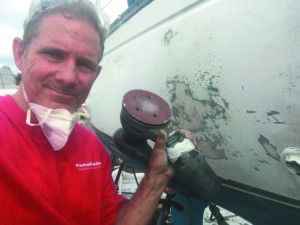
2. TOPSIDE PAINT
The hull sides were last painted in 2014 with Interlux Brightside. In our testing, the paint’s gloss still rated “Good” after three years. After seven years in Florida, gloss is long-gone and so is adhesion. Whichever route I go, I’ll be removing the original paint, and fairing, priming, and repainting.
The most surprising find so far was that the Franmar Soystrip Marine Coating Remover left over from a 2016 project was still very potent. After a 24- hour soak under 4-mil black plastic, the paint came right off with a flat scraper. To remove all the paint, I needed to follow with 50-grit on my Porter Cable random orbital sander, but the Soystrip gave me a head start.
My tentative plan is for a professionally sprayed two-part LPU paint, but a roll-and-tip job is not out of the question. PS has several reports on finishing, and my experience painting our Catalina 22 using Epifanes two-part polyurethane and Interlux Perfection gives me the confidence that with a good helper I could do it again.
• “Do-It-Yourself Fairing and Filling,” PS August 2017
• “Topside Paint Endurance Test 3-year Checkup” PS December 2102
• “Random Orbital Sander Runs Circles Around Hand Sanding” PS Bulletin
3. LUBRICATE SEACOCKS
Hitchins noted two frozen seacocks on the bronze thru-hulls that had been replaced in 2012. “Lubricate and exercise all seacocks,” was his advice. The advice is so common that surveyors almost instinctively insert it into every survey, but it would surely raise a few eyebrows among the landlubbers new to sailing jargon. This being my second 50-plus year old boat, I was familiar with the drill, but still I flipped back to three helpful reports on the topic:
• “Keep Seacocks Working Smoothly,” PS June 2011
• “Caring for Seacocks,” PS March 2018
• “More Boat Tips: Unsticking Nuts and Bolts,” Inside PS Blog
More to come, of course. Questions? I’m at [email protected].
































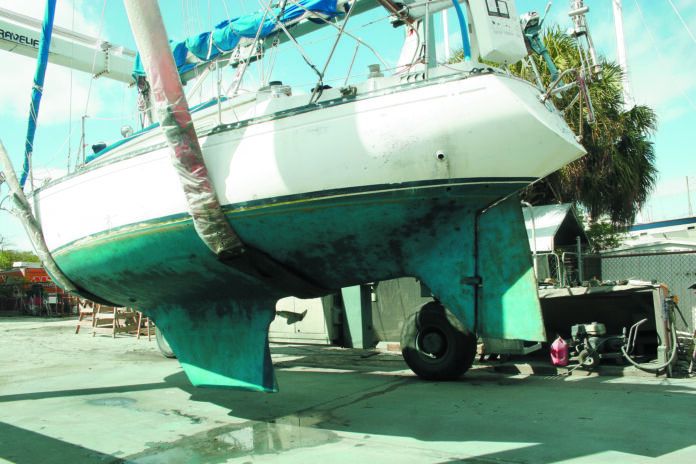
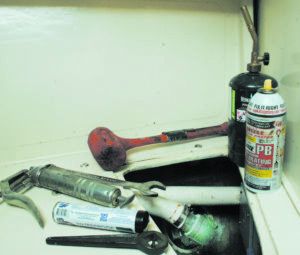
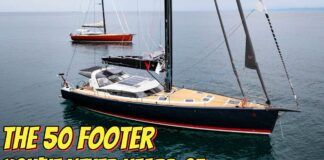



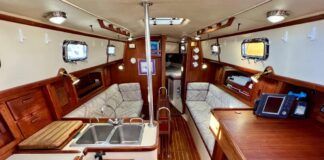
I am a subscriber. My diver showed me rust on my keel. Do you have any suggestions on what to do?
Gerald Pollack
Surveyors are a mixed bag. They have a built in conflict of interest. You pay them, but your wishes are generally not accounted for because the surveyor owes his allegiance to insurance companies whom they think there end product is destined. Even if it is not, many surveyors will not take into account your wishes as some may feel their opinion and perceived impartiality is more important than the guy paying him. If this is a problem, work it out with the surveyor in advance and move on if you don’t like the answers.